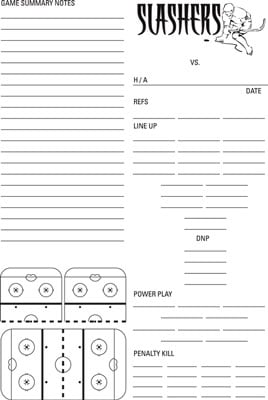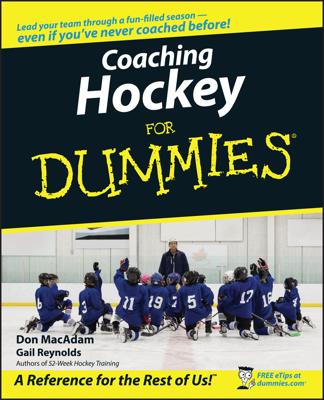This is the moment you’ve been waiting for as a coach — your chance to shine as a great hockey strategist. The game is about to begin. Your beginners are stepping onto the ice. Some lose their balance and fall. What strategies do you need to employ to have a successful game? Read on to find out!
Getting your priorities straight

First, forget trying to win the game. The kids have more important things to do, like getting to play a lot and having fun.
When you coach beginning hockey players, remember these three major coaching strategies, which lead to having a successful game:
Maximize the opportunity for players to develop their basic skills, primarily skating.
Ensure that all team members have fun.
Begin to help the kids learn a bit about the game.
The means to employing these three strategies are quite simple. First, give every player equal ice time. That lets everyone play as much as possible, so they all get time to develop their skating. Secondly, rotate all players through all positions. This gives each player a feel for the game from different perspectives. It also allows different skills to evolve, so they’ll eventually find out what they’re good at doing and what position they like most.
You will likely need to provide simple game instruction to help beginners start to develop some game sense. For example, typically, beginners all converge on the puck. Instruct them that the nearest player to the puck is to go after it; the others should spread out not too far away, heading toward the goal they want to score in. This will put them in a position to receive a pass or go for a loose puck.
Beginners typically try to carry the puck rather than look for pass opportunities, or they simply send the puck in any direction. So some instruction, such as “find a teammate to pass to,” may be useful.
Sometimes you get a beginner who’s simply lost out there, so he just stands around watching or looking for his parents in the stands. Instruct players to always be skating in the direction the puck is going, so they have a focus and at least get some skating practice. This will also increase their odds of accidentally getting involved in the play, which will give them a bit of experience and, hopefully, satisfaction.
This game strategy is about all you need at the beginner hockey level. However, beyond the game, there are a few other coaching strategies that you may want to consider further, such as keeping everybody happy, helping everyone accomplish something, and stopping periodically to take an objective look at how you are doing as a coach.
Keeping everybody happy
First of all, don’t feel bad if you discover that there’s just no way you can keep everybody happy! The dynamics of a team often don’t allow for peace and harmony all the time. But you can use certain strategies to help you avoid the common pitfall of trying to keep everyone happy.
Be clear in your own mind about the goals you set prior to the season. Then be sure all goals are clearly defined, understood, and accepted by your staff, players, and parents. Thereafter, when someone is unhappy about an issue, you can point to the appropriate goal(s) to help keep individuals focused and help them understand your position on the issue.
Then, be consistent. You’ll have times when it may seem easier to give in to a player or parent and deviate from your predetermined goals and strategies just to make someone happy. This usually results in a short-term happy for one person and a long-term unhappy for the rest of the team — and for you. If you remain consistent, everyone will know what to expect, and they’ll pressure you less to make exceptions.
Generally, players want to play and parents want to see their kid(s) play. Keep that in mind as an overall strategy, and you’ll keep most people happy most of the time.
Another way to keep people happy is to solicit feedback. This is particularly useful during the season if you don’t feel you have a good read on participant satisfaction. Your hockey staff or parent assistants should be your first source of feedback. They should feel comfortable offering feedback any time, without you having to solicit it.
With young players, a casual mid-season team meeting following a practice or during a holiday pizza party may provide sufficient feedback. Informally ask questions: How’s the season going for you? What do you like about what we’re doing? What don’t you like? Most players will be happy you cared to speak with them.
If you feel the need, a mid-season parent meeting could be useful. Take the approach that this should be more an information session than a parent gripe session. Control the agenda: Give parents an update on the team, report on how the team strategies are working, and lay out any changes you feel need to be made. Have at least one assistant present at these meetings so that you present a common team front. Never let discussions get personal. Issues are about the team. The kids’ goals are the priority.
Helping everyone accomplish something
Both players and parents can be kept reasonably happy if you provide opportunities to experience a sense of accomplishment through games and practices. One way to do this is to set attainable goals for each practice session and to help all players reach the goals. Players will leave the rink feeling good about what was accomplished.
List these goals in your plan at the first of the year. An example for the practice following backward skating instruction is to have all players be able to skate the length of the ice backwards without falling by the end of practice. These accomplishment goals can be simple. The important thing is that they are doable, which gives the players a sense of satisfaction. It also gives the coach something — an objective measure of progress.
Another way to see accomplishment is to use simple tests to check progress. This, in turn, provides positive feedback for players. These tests can be as basic as timing players as they skate one lap of the ice. Be sure to record the results of any test you use. As skating improves, retest and show players how much faster they are. The results will help you show players what gains they are making, and you can all see what you are accomplishing as the season progresses.
Keep individual test results between you and the player or compare players to themselves, not to others on the team. Having a player suffer the embarrassment of being last on a particular test serves no purpose. However, positive pieces of information can be motivational for the team.
Positive reinforcement helps to create the environment needed for accomplishing goals. Always make tests, drills, and practices overflow with positive reinforcement. Verbal and visual encouragement, such as a high five, glove tap, or pat on the helmet, can work wonders in the development and sense of accomplishment of young players.

